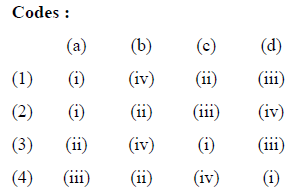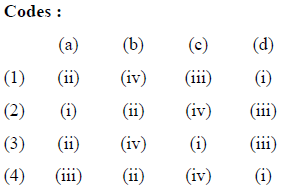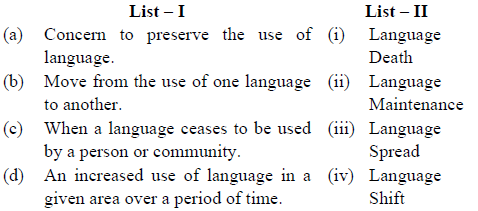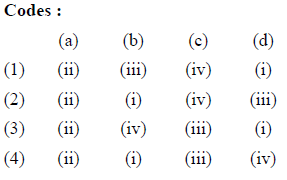LINGUISTICS
Paper – III
Note : This paper contains seventy five (75) objective type questions of two (2) marks each. All questions are compulsory.
1. Match he following :


2. Match the following :


3. The mutual exclusiveness of a pair of sounds in a certain phonetic environment is termed as
(1) Free variation
(2) Elision
(3) Complementary distribution
(4) Syncopation
4. Functional relationship between two rules where application of one rule prevents a feeding relationship is termed
(1) Feeding ordering
(2) Bleeding ordering
(3) Counter-feeding ordering
(4) Counter-bleeding ordering
5. Assertion (I) : Sound segments are sonorant if they exhibit spontaneous voicing
Assertion (II) : Sound segments are sonorant if the suppression of air is below that of the level of glides
Codes :
(1) Both (I) and (II) are correct
(2) (I) is correct and (II) is false
(3) (I) is false and (II) is correct
(4) Both (I) and (II) are false.
6. When all the affixes are taken out of the English word ‘ungrammaticality’, the remainder is called a
(1) Base
(2) Stem
(3) Root
(4) Morpheme
7. A branch of morphology, that usually takes what is called an item-and-process approach and instead of analyzing a word form as a set of morphemes arranged in a sequence, a word form is regarded as the result of applying rules that alter a word form or stem in order to produce a new one, is
(1) lexeme-based morphology
(2) word-based morphology
(3) morpheme-based morphology
(4) phonotactic morphology
8. A hypothesis, which entails that syntactic transformations operate on syntactic constituents only, and can only insert or delete designated elements, is
(1) Base-Rule Prykothesis
(2) Lexicalist hypothesis
(3) Separation hypothesis
(4) Distributed morphology
9. Assertion (I) : In grammar, clitic refers to a form which resembles a world.
Assertion (II) : In grammar, clitic refers to a form that is dependent on a neighbouring word in a construction.
Codes :
(1) Both (I) and (II) are true
(2) (I) is true and (II) is false.
(3) (I) is false and (II) is true.
(4) Both (I) and (II) are false.
10. Assertion (I) : An Endocentric construction refer to a group of syntactically related words where one of the words is functionally equivalent of the group as a whole.
Assertion (II) : An Exocentric construction refers to a group of syntactically related words where some words are functionally equivalent to the group as a whole.
Codes :
(1) Both assertion (I) and (II) are false.
(2) assertion (I) is true and (II) is false.
(3) assertion (I) false and (II) is true.
(4) Both assertion (I) and (II) are true.
11. Assertion (I) : Deixis subsumes those features of language which refer directly to the personal, temporal or locational characteristics of the situation within which an utterance takes place.
Assertion (II) : The notion of deixis has proved fruitful in language acquisition studies where researchers view its acquisition/learning by children as a significant feature of early language development.
Codes :
(1) Both (I) and (II) are correct.
(2) (I) is correct, (II) is incorrect
(3) (I) is incorrect, (II) is correct.
(4) Both (I) and (II) are incorrect.
12. Assertion (I) : Strong crossover occurs when the pronoun is in an argument position, i.e. it is an argument of the relevant verb and is not contained inside a noun phrase.
Assertion (II) : Weak crossover occurs when coreferential reading is marginal i.e. when the coreferential reading is not clearly unacceptable, but is rather unlikely to occur. Here, the expression that has been crossed over may be a possessor inside a noun phrase.
Codes :
(1) Both (I) and (II) are correct.
(2) (I) is correct, (II) is incorrect.
(3) (I) is incorrect, (II) is correct.
(4) Both (I) and (II) are incorrect.
13. An optional rule proposed to handle the way constituents permute in free word order languages, and which may be stylistic in character is
(1) Wh-movement
(2) Deletion
(3) Topicalisation
(4) Scrambling
14. ‘What you are is a fool’, is an example of
(1) Question formation
(2) Wh-movement
(3) Pseudo-cleft sentence
(4) Cleft sentence
15. Which of the following are not correctly matched ?
(1) DP analysis – Abney
(2) Case Grammar – Filmore
(3) Conditions on Transformations – Jackendoff
(4) Minimalist Program – Chomsky
16. From the lexical relationship point of view, the word ‘flower’ is said have the following relation with the word ‘tulip’ :
(1) Synonym
(2) Hypernym
(3) Hyponym
(4) Homonym
17. _______ is a term used by many linguists to refer to language used for establishing an atmosphere or maintaining social contact rather than for exchanging information or ideas.
(1) Polysynthesis
(2) Phatic communion
(3) Semiology
(4) Hetrography
18. Developed as a branch at mathematical logic an approach for a formal account of the meanings of legitimate expressions in a language, is
(1) Lexical semantics
(2) Model-theonetic semantics
(3) Montague Grammar
(4) Prototype theory
19. The following sets :
Narrow : Wide
Tall : Short
Weak : Strong
Small : Large
are grouped as
(1) Complementary Antonyms
(2) Gradable Antonyms
(3) Converses
(4) Ungradable Antonyms
20. Lakshana denotes
(1) Indication
(2) Literal meaning
(3) Suggested meaning
(4) Ambiguity
21. The idea of the family tree model of genetic linguistic relationships in historical linguistics has come from
(1) Geology
(2) Anthropology
(3) Biology
(4) Genetics
22. The phenomena of ‘change’ and ‘diffusion’ in historical linguistics
(1) are really similar
(2) share no relationship at all
(3) really contrast
(4) diffusion occurs only in IE whereas change may occur in all languages.
23. Old English only knew two tenses, a present and a past-tense, but the Modern English also has the opposition between the ‘simple’ and the ‘progressive’ forms. Such a change is
(1) Morphological
(2) Semantic
(3) Pragmatic
(4) Syntactic
24. As case endings disappeared in the Middle English period, the various functions of the inflected old English cases (such as that of indirect object, or of adverb, etc.) were increasingly taken over by prepositional phrases with uninflected nouns.Modern English has lost most of its original inflections. Such changes are
(1) Lexical
(2) Semantic
(3) Morphological
(4) Pragmatic
25. Assertion (I) : In situations of long and rather stable language contact, bilingual speakers tend to make their languages structurally more similar to ease communication and the acquisition of the other language(s).
Assertion (II) : Unlike the piecemeal borrowing, this mutual convergence of different linguistic systems typically involves languages of similar social status, and brings about changes in all the languages involved.
Codes :
(1) Both (I) and (II) are true.
(2) (I) is true but (II) is false.
(3) (I) is false, but (II) is true.
(4) Both (I) and (II) are false.
26. The terms ‘restricted’ and ‘elaborated’ codes were introduced by
(1) John Gumperz
(2) William Labov
(3) Basil Bernstein
(4) John Lyons
27. Assertion (I) : Language in a strong marker of identity.
Assertion (II) : The forms of language variation serve to identify people belonging to an area, a social group, gender or an age group.
Codes :
(1) Both (I) and (II) are true.
(2) Both (I) and (II) are false.
(3) (I) is true, but (II) is false.
(4) (I) is false, but (II) is true.
28. A language which is widely used in some region for communications among people
speaking a variety of languages is called
(1) Pidgin
(2) Creole
(3) Langue
(4) Lingua Franea
29. Assumption (I) : Bilingualism can be the property of an individual but equally it can be property of an entire speech community in which two or more languages are used.
Assumption (II) : There is no evidence that children raised bilingually tend to be more expressive, more original and better communicators than children raised with only one language.
Codes :
(1) (I) is true, but (II) is false.
(2) (I) is false, but (II) is true.
(3) Both (I) and (II) are true.
(4) Both (I) and (II) are false.
30. Match the items in List – I with those in List – II and choose the correct code.


31. An ability of humans, which supports the suggestion that they are innately programmed to acquire language, is
(1) acquisition of discourse in late childhood.
(2) infant vocalizations.
(3) the apparent ease with which they acquire language.
(4) the ability to fully acquire language by the age of puberty.
32. The concept of ‘stages’ in language acquisition was introduced during
(1) the period of Large sample studies.
(2) the period of Longitudinal studies.
(3) the period of Diary studies.
(4) the period of Panini
33. A heuristic step in language processing which is essentially a kind of principled guess about how the words we are hearing fit into a syntactic structure is called
(1) Phrasal step
(2) Epicenter of decoding
(3) Perceptual strategy
(4) Communicative strategy
34. Non-fluent speech, difficulty in production of morpho-syntactic structures naming difficulties comprehension largely intact in cases of neural injury, is known as
(1) Anomic aphasia
(2) Broco’s aphasia
(3) Wernicke’s aphasia
(4) Global aphasia
35. Difficulty in speech production due to neuro-motor pathology is known as
(1) Stammering
(2) Dysphonia
(3) Wernicke’s aphasia
(4) Dysarthria
36. Which of the following is not correct in the context of L1 acquisition and L2 learning contexts ?
(1) Age and cognitive maturity levels are different.
(2) Metalinguistic awareness is present in one or not in the offer.
(3) Linguistic input provided by the environment is different in quality as well as quantity.
(4) Phenomenon of language transfer and/or interference can be seen in one and not the other.
37. Which of the following is not correctly matched ?
(1) Children follow the same path in learning a language, and when adults learn a foreign language they use the same path they used when learning/acquiring their mother tongue. – Natural order hypothesis
(2) Factors like intelligence, memory, attention, etc. have a primary role in language acquisition/learning. – Innateness
(3) Points of structural difference are identified and these are studied in areas of potential difficulties. – Contrastive analysis
(4) Models of description built from a combination of features originating in more than one linguistic theory. – Eclecticism
38. Assertion (I) : Contrastive Analysis hypothesis proposes that similarities between L1 and L2 will facilitate the learning process whereas contrasting structures in L1 and L2 will be difficult to learn.
Assertion (II) : Uriel Weinreich (1953) was the main proponent of CA hypothesis in language reaching.
Codes :
(1) Both are true.
(2) Both are false.
(3) (I) is true, (II) is false.
(4) (I) is false, (II) is true.
39. (I) Integrative approaches to language testing are based on the assumption that different units of language at the phonological, morphological, syntactic levels, and different skills can all be tested independent of each other.
(II) Close test and Dictation are both examples of ‘Integrative approaches’ to language testing.
Codes :
(1) Both are true.
(2) Both are false.
(3) (I) is true, (II) is false.
(4) (I) is false, (II) is true.
40. Four levels of literacy identified by wells (1987) are from very basic to the high, identify the correct order of these levels of literacy from the basic to the highest, from the minimum to the maximum.
(1) Informative, Performative, epistemic, functional.
(2) Performative, informative, epistemic, functional.
(3) Epistemic, informative, functional, performative.
(4) Performative, functional, informative, epistemic.
41. Language typology is primarily concerned with
(1) Common Genealogical Origin
(2) Language contact
(3) Language convergence
(4) Universal preferences
42. If a language has voicing contrast among the fricatives, it is very likely to have voicing contrast among the
(1) Plosives
(2) Affricates
(3) Nasals
(4) Approximants
43. The head parameter specifies the position of the head in
(1) a sentence
(2) a clause
(3) a phrase
(4) a paragraph
44. Rule ordering conventions belong to
(1) Logical Universals
(2) Semantic Universals
(3) Substantive Universals
(4) Formal Universals
45. Clause-final complementizers like /a:ni/ in Telugu or /bole/in Bengali are an areal features that is supposed to have spread from the
(1) Indo-Aryan family
(2) Dravidian family
(3) Austroasiatic family
(4) Tibeto-Burman family
46. Assertion (I) : Bilingual dictionaries can be distinguished as active dictionaries or passive dictionaries, according to whether their purpose is to help with encoding (writing) or decoding (reading) activities.
Assertion (II) : By providing lexical equivalents, the monolingual dictionary helps language learners and translators to read or create texts in a foreign language.
Codes :
(1) Both (I) and (II) are true.
(2) (I) is true, (II) is false.
(3) (I) is false, (II) is true.
(4) Both (I) and (II) are false.
47. Match the items in the List – I with List – II and select the correct answer from the codes given below :


48. ‘A grief ago’ is an example of
(1) Parallelism
(2) Hyperbole
(3) Synechdoche
(4) Deviation
49. Which of the following is not true for making a successful translator ?
(1) He/she should indulge in a word-for-word translation.
(2) He/she should translate idiom for idiom and metaphor for metaphor as for as possible.
(3) He/she should translate intention by intention.
(4) He/she should transcreate but must not embellish.
50. Match the items of List – I with those of List – II in the context of equivalence in translation.


51. DTAG, BRAT, XCDG are names of ______.
(1) Famous Text Corpora
(2) Syntactic Annotation Tools
(3) Corpora Projects
(4) Text-to-Speech Tools
52. Which of the following languages is not a part of the TDIL corpora initiative ?
(1) Tulu
(2) Konkani
(3) Bodo
(4) Manipuri
53. In Brown Corpus, the tagset PP$ stands for ______.
(1) Pronoun Possessive
(2) Determiner Possessive
(3) Pronoun Singular, Reflexive
(4) Pronoun Plural, Reflexive
54. Henry Kuāra and W. Nelson Francis compiled ______.
(1) The British National Corpus
(2) American National Corpus
(3) Brown Corpus
(4) Corpus of Contemporary English
55. From the ‘item-and-arrangement’ point of view.
(I) A word like ‘dogs’ is viewed as a set of morphemes which include a root with its corresponding exponentor morph and a plural morphene with its corresponding morph.
(II) Each piece of morphosyntactic information is paired with some morph or exponent.
(III) A word like “cats” is viewed as a rule that applies to a root paired with a set of morphosyntactic features.
(IV) The resulting phonological sequence of a combination of morphs is treated as a single piece and not as a composite of morphs.
Codes :
(1) (I), (II) (III) & (IV) are correct.
(2) Only (I) and (II) are correct.
(3) Only (I) and (III) are correct.
(4) Only (II), (III) and (IV) are correct.
56. Which of the following statements is not correct ?
(1) Copy theory of movement is endorsed by the Minimalist program.
(2) When a constituent moves it leaves a copy of itself.
(3) A chain consists of multiple copies of the moved constituent.
(4) Copy theory replaces the case theory.
57. The use of dummy ‘do’ in English, which takes place only when other options for realizing tense and agreement are blocked can be referred to as an example of
(1) Greed
(2) Procrastinate
(3) Spell-out
(4) Last resort
58. In the Minimalist program, a general economy constraint allowing the movement of an element only if it satisfies the requirements of the moved element is
(1) Greed
(2) Spell-out
(3) Procrastinate
(4) Last resort
59. In later Government and Binding theory, the term tense phrase (TP) is used for what was earlier called
(1) an Inflection Phrase (IP)
(2) a Complementizer Phrase (CP)
(3) a Determiner Phrase (DP)
(4) a Prepositional Phrase (PP)
60. In configurational languages grammatical relationships within constructions are expressed mainly by
(1) Word order
(2) Inflections
(3) Derivations
(4) Prfixation
61. Prosodies are features in prosodic phonology that
(1) extend over stretches of utterance.
(2) do not extend over stretches of utterance.
(3) subsume pitch but not stress.
(4) do not include secondary articulation.
62. A floating tone in Auto segmental phonology
(1) is one which docks with a consonant after the application of a phonological rule.
(2) is one which constantly attached to a syllable.
(3) is one which has been separated from a syllable following the application of a phonolgoical rule
(4) is one which can never be detached from a syllable.
63. In Auto segmental phonology, obligatory contour principle prohibits
(1) two nasal consonants from being adjacent.
(2) two identical oral consonants from being adjacent.
(3) two identical vowels from being adjacent.
(4) two identical tones from being adjacent.
64. An approach in phonology where an input representation is associated with a large class of candidate output representations, and various kinds of filters are used to evaluate their outputs and select the one which is most well-formed is called
(1) Prosodic theory
(2) Metrical theory
(3) Natural theory
(4) Optimality theory
65. The mechanism of GEN in optimality theory is
(1) only able to add a segment of sound.
(2) only able to delete a segments of sound.
(3) only able to rearrange segments of sound.
(4) able to add, delete and re-arrange segments of sound.
66. Social motivation of sound change was popularized mainly leg the publications of
(1) U. Weinreich
(2) P. Trudgill
(3) J.J. Gumperz
(4) W. Labov
67. In a number of studies on disglossia and gender around the world, there is a tendency to use the more prestigious language by
(1) women
(2) men
(3) both women and men
(4) neither women nor men
68. If literacy is acquired by an individual as a skill, generally within an educational context, it is called
(1) Functional literacy
(2) Survival literacy
(3) Technical literacy
(4) Autonomous model of literacy
69. As a critique of Chomsky’s concept of ‘linguistic competence’, the concept of ‘communicative competence’ was proposed by
(1) André Martinet
(2) Victoria Fronkin
(3) Dell Hymes
(4) John Gumperz
70. We have been able to understand how the middle class has ties through their jobs and neighbourhoods, etc to community members above and below them on the socioeconomic spectrum with the help of the
(1) Social network
(2) Language ideology
(3) Power politics
(4) Language attitudes
71. Assertion (I) : Paul Broca proposed the localization of language in human brain.
Assertion (II) : Paul Broca posited the notion of cerebral dominance.
Codes :
(1) Both (I) and (II) are true.
(2) (I) is true, but (II) is false.
(3) (I) is false, but (II) is true.
(4) Both (I) and (II) are false.
72. Assertion (I) : In evolution of language early language would have been analytic.
Assertion (II) : Bound forms are mostly derived from free forms.
Codes :
(1) (I) is true, but (II) is false.
(2) (I) is false, but (II) is true.
(3) Both (I) and (II) are true.
(4) Both (I) and (II) are false.
73. Converging evidence from studies of aphasia, split-brain patients and other studies points to left hemisphere dominance for language organization and processing in
(1) all humans
(2) only split-brain humans
(3) only left-handed humans
(4) most humans
74. Production and comprehension are
(1) totally different.
(2) reverse processes.
(3) process that always reconstruct the message in the same way.
(4) similar in some and different in other operations in processing.
75. A language disorder which is characterized by errors in the use of content words, infrequent words taking longer to retrieve, typical error patterns related to mental lexicon, is
(1) Dysarthria
(2) Paraphasia
(3) Ecolalia
(4) Developmental dyslexia
Latest Govt Job & Exam Updates: